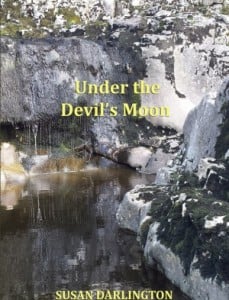Susan Darlington: Under the Devil’s Moon
July 6, 2015
The title of Susan Darlington’s recent poetry collection, Under the Devil’s Moon, gives a fair indication of the contents. Almost all of the poems conjure a dream-like atmosphere, as stories of transformation and folk-tale violence straddle the boundaries of symbolism, surrealism and magical realism in attempting to evoke emotional truth.
Darlington is a Leeds-based poet and arts journalist, with a particular interest in music. A number of her poems have epigraphs from rock bands and musicians (Smog, Ryan Adams…) and her publisher’s biography (Penniless Press) puts her into context in almost entirely musical terms, stating, “Susan Darlington was born in the year that punk broke and remains inspired by three-chords and the DIY ethic, especially as practiced by Riot Grrrl”. This suggests a spiky, immediate quality to the writing, and although the former may be true, any immediacy in the writing is of an emotional rather than a naturalistic kind.

Opening poem Queen Bee sets the tone, as we move from a schoolgirl with a bee caught in her hair, to that girl’s invocation of the spirit of the bee as “a protector / that can deflect the verbal stings and barbs / and make them realise that I am Queen Bee”.
The notion of transformation of this kind for emotional defence goes back at least as far as classical mythology, but Darlington makes the mythology in this volume an extremely personal one. This makes for some viscerally powerful individual poems, such as the defiant triumph of Magpie, where, in response to a male voice who dislikes everything about the speaker:
…she flapped her wings once
for sorrows past, and twice for joy
as she pecked the jesses off her feet
and as she rose in slow, lazy circles
towards the glittering slice of moon
she felt lost songs bubbling in her throat.
Occasionally, we retain a toehold in the naturalistic world – Queen Bee’s schoolgirl in the playground, the late-running train of Moths, trainers caught in the branches in Shoe Tree or, most strikingly, in Cooking at St Mary’s, a speaker who reacts to the condescension and disdain of a woman called Heather by chopping, dervish-like, through a punnet of tomatoes. Also, a couple of vérité descriptions of suicides (The Canal Bridge and Falling) pack a real punch by avoiding the figurative language that prevails elsewhere. However, most often, we are left to map our own place in a world of dreams and symbols with no fixed landmarks. As I acknowledged above, this makes for powerful individual poems, but over the course of the collection, leaves the reader somewhat adrift, guessing at the emotional ferment that lies behind the symbolic animal or body of water in each poem.
A recent collection that appeared to me to cover similar territory, Pascale Petit’s Fauverie, in which the animals of the big cat house in Paris’s Jardin des Plantes zoo (among others) accompany the reader on an intense emotional journey. However, Petit gives context for this journey – a reunion with an estranged father, shortly before that father’s death – thus channelling both her own emotional impact and the reader’s response. Darlington provides no such clues, leaving us to guess at cruelties, break-ups, break-downs and recoveries, without ever being confident we’re on the right track.

Stylistically, most of the pieces in Under the Devil’s Moon use a supple, musical free verse in constructing short lyrics. Darlington has a consistent, engaging voice that gives immediacy and power to the images she uses, even if not to what lies behind them. Snow Cover Me begins with an appropriately crystalline clarity:
Fat, dry flakes of snow
coat the branches of winter thin trees,
the drifts creating brittle vibrations
that whisper muffled words to the air.
The simplicity of the diction puts us right into the scene, ready for the emotional chill and self-defensive numbness that the rest of the poem will evoke.
There are just a couple of occasions in which Darlington steps outside this free-verse lyricism to embrace something more experimental, but they tend to leave me wanting more. I particularly like Silence, where an initial five line stanza is repeated with the loss of a line and a number of words each time, leaving a final stanza of a single word – “Silence”.
There is plenty to admire in the craft and emotional power of Under the Devil’s Moon, and some of the poems will stay with me, but I can’t help wishing for the kind of punk rock, Riot Grrrl engagement and confrontation with the reader – rather than the writer’s own psyche – that I felt I had been promised. There are enough indications in the collection to suggest that she’s well capable of this.
Under the Devil’s Moon can be purchased from Penniless Press
Susan Darlington’s blog can be found here
Mike Farren




Comments